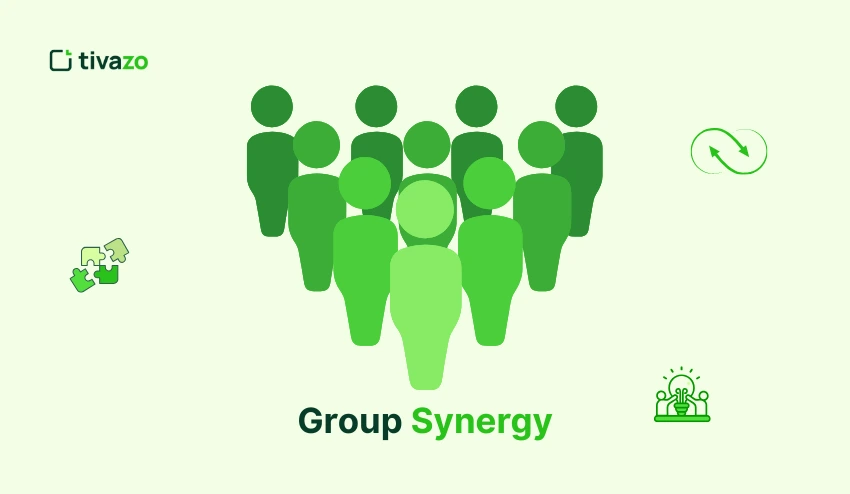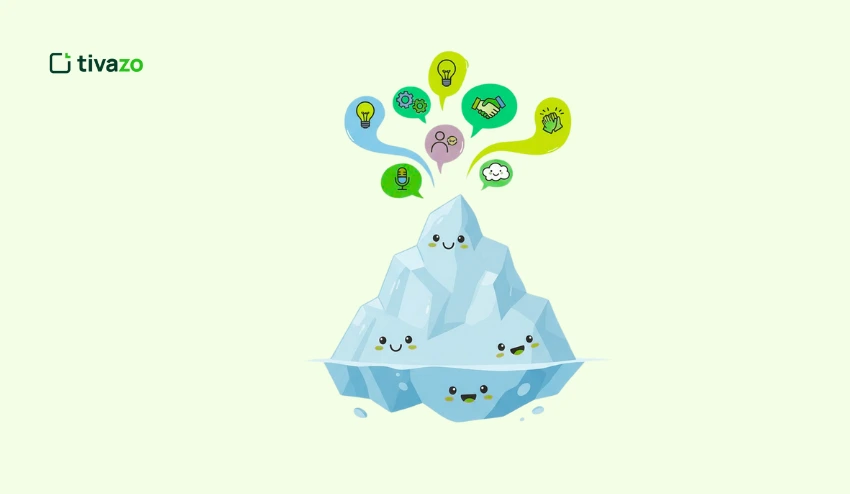Consider a group where ideas just flow, work is done efficiently, and all the members feel appreciated- this is the magic of group synergy.
Group synergy is not a buzzword; it is what makes high-performance teams. The outcomes of a successful collaboration between team members tend to be more than satisfactory, especially when they apply different skills and opinions to the task. Harvard Business Review cites that collaboration and communication-oriented teams are up to 25% more productive than other teams.
In the high-pressure work environment, group synergy is the key element in increasing team productivity, problem-solving, and overall morale. Whether it is collaborative teamwork or good team dynamics, knowing how to develop this synergy can change the performance of a group. In this article, we will discuss what group synergy is, why it is important, and practical steps to develop a strong, high-performance team.
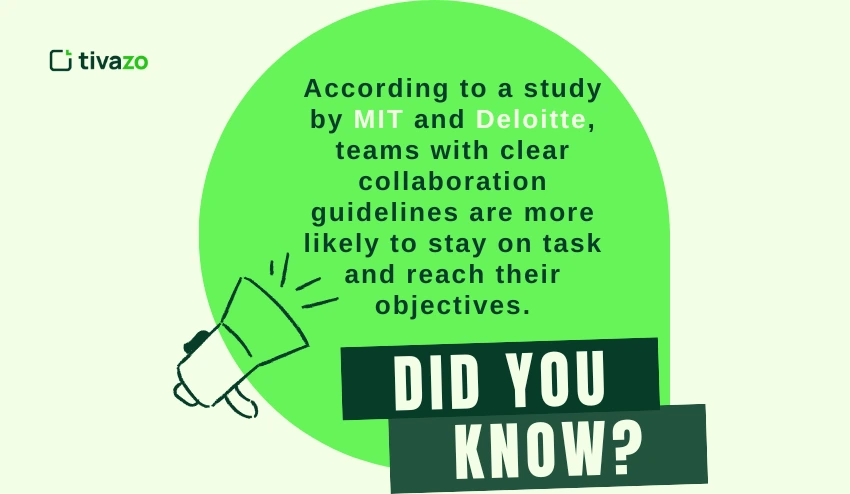
What Is Synergy?
Synergy is the concept that the combined efforts of a group can produce a result greater than the sum of individual contributions. In the workplace, this implies that when the team members work together, they can accomplish more, which would not be possible individually.
What Is Group Synergy?
Group synergy can be defined as a benefit in terms of increased performance and productivity when teams perform and cusing their own assorted abilities, strengths, and viewpoints. It is more than mere teamwork- group synergy is achieved when there is smooth working together, open communication, and an individual member applies his or her expertise to reach a common goal. This type of collaboration enables teams to resolve complex issues quickly, innovate more resourcefully, and attain outcomes that are much higher than the equivalent of one.
How to Build Synergy While Working with a Team?
The process of creating group synergy begins by creating an environment of open communication. When the team members are not afraid of sharing their ideas, giving feedback, and talking about the difficulties, the collaboration becomes more fluent, and misunderstanding is reduced. Active listening and frequent check-ins allow teams to focus on their goals and enhance team unity, which, in the end, can lead to better performance within a group and increased team productivity.
It is also essential to establish specific roles and responsibilities and encourage trust and respect. Every member is expected to be aware of what he or she is supposed to do and how this helps in achieving the group’s goals. The trust is established through transparency, reliability, and consistency, which allows team members to cooperate and assist each other. Teams that develop this dynamic experience experience greater collaborative teamwork, work more efficiently, and the synergy of the organization is observed to be increased significantly.
Lastly, successes should be celebrated and team development should be invested in to maintain synergy in the long run. Individual and group achievements are acknowledged, which boosts morale, and team-building activities and professional development opportunities are more likely to build relationships. Through their continued cultivation, teams will be able to access creative problem-solving, become innovative, and sustain high degrees of group efficiency, transforming a group of people into a truly synergistic entity.
Importance of Synergy in Teamwork
An important contributor to team success is group synergy, which allows members to pool together their talents and views in order to achieve more. Through teamwork and unification, teams are able to accomplish so much more than what an individual would have done on his or her own.
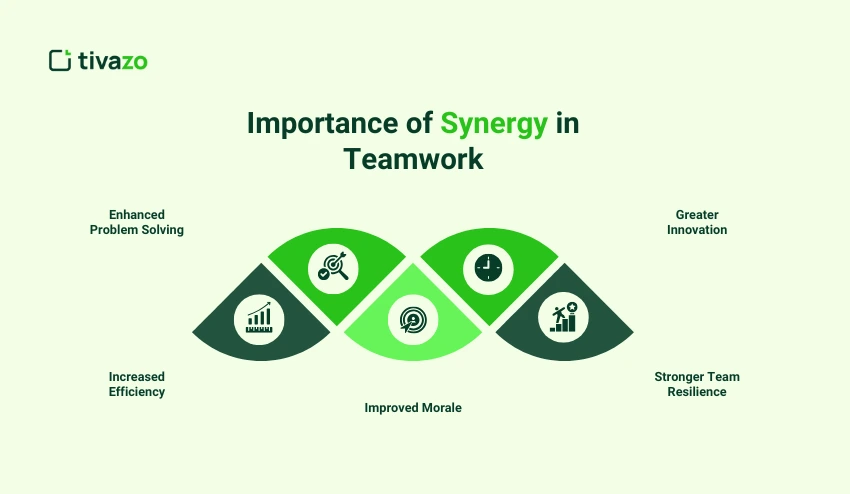
1. Enhanced Problem Solving
Teams that exhibit strong group synergy are better off because they will have different perspectives that will result in more creative solutions and wiser decision-making. Members are able to discuss and come up with various solutions, and the team will be able to address challenges more efficiently when they feel secure and free to express their ideas. Research by MIT has shown that diversified teams solve problems quickly and with better results.
2. Increased Efficiency
Group synergy will assist in eliminating redundancies and will also help in assigning tasks to each member based on his or her strengths. With improved workflows and less overlap, teams are more efficient and save resources and time, increasing the productivity of the entire team. Effective teamwork also reduces mistakes and ensures the project stays on schedule, making the importance of unity in the team clear.
3. Improved Morale
An effective team that has group synergy has an environment that is positive and supportive, boosting employee engagement and satisfaction. Individual and group success can be recognized, which improves relationships and stimulates further cooperation. Good morale has a direct impact on the performance of the team and on minimizing turnover within the workplace.
4. Greater Innovation
Teams that are synergistic have greater chances of experimenting, being innovative, and adapting to the changes in their environment. Group synergy fosters the concept of creative problem solving, whereby the teams are able to apply new ideas successfully and keep competition at bay. Companies whose teams are innovative and synergistic tend to perform better than others in the development of products, services, and solutions.
5. Stronger Team Resilience
High-synergy teams are in a better position to cope with failure and deal with difficulties as a team. Trust, effective communication, and support help the group to heal fast and keep up the pace during times of change. Dynamic work environments are those where resilient teams are more agile and guarantee long-term success and stability.
In short, group synergy in teamwork is not only good, but it is a must to ensure high performance, innovation, and long-term success. Teams that are centered on collaboration, trust, and communication are in a better position to achieve goals and overcome challenges in unison.
How to Measure Your Group Synergy
Group synergy is a metric that is crucial to comprehending the effectiveness of teamwork and the ability to accomplish collective objectives. Monitoring processes and outcomes enables an organization to determine the strengths and weaknesses of its teams.
1. Performance Metrics
One direct measure of group synergy is performance measures. The ability to evaluate the team on the basis of meeting deadlines, accomplishing goals, and maintaining quality output illustrates the effectiveness of their teamwork and their ability to build on the strengths of others. Regular monitoring of progress also assists in identifying those areas where synergy needs improvement.
2. Team Cohesion
Team cohesion is an indicator of how members trust, communicate, and collaborate. High group synergy is also demonstrated when team members help one another, solve conflicts in a positive manner, and pursue shared goals. Such tools as observation and team evaluation can be used to measure the cohesion and find ways of improving the collaboration.
3. Employee Satisfaction
Group synergy is an essential element of concern that is measured by employee satisfaction. It is possible to survey the team members on their experience regarding their work in teams, leadership, and communication to understand how effectively the team works as a whole. Better collaboration, motivation, and performance of the team is usually associated with higher levels of satisfaction.
4. Feedback Mechanisms
Feedback loops are critical to group synergy. Teams should learn to be constantly improving their processes by welcoming positive feedback, acknowledging success, and dealing with challenges as they emerge to keep a team culture of collaboration. Feedback keeps the synergy dynamic and changing with the requirements of the team.
Measuring group synergy well assists an organization in maximizing teamwork, maximizing productivity, and creating a positive team culture. Frequent evaluation enables groups to enhance bonds and sustain high performance in the long run.
Ways to Build a Creative Synergy Group
The teams that wish to innovate and solve problems successfully should foster a creative synergy group. The collaboration of the culture of creativity enables teams to come up with ideas that surpass individual input.
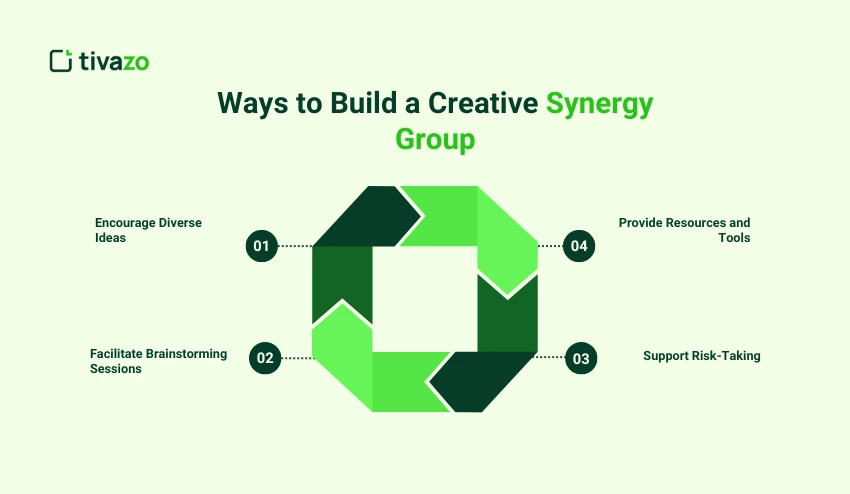
1. Encourage Diverse Ideas
Group synergy depends on the promotion of diverse ideas. By establishing an environment in which all team members feel free to express their own viewpoints, a team is able to consider a greater variety of solutions. Thinking diversity increases problem-solving and leads to a more inclusive, innovative working environment.
2. Facilitate Brainstorming Sessions
Brainstorming sessions on a regular basis ensure there is group synergy as well as creativity. Through open exchange of ideas and sharing ideas, members feed on the ideas of others, hence solutions that no individual can develop on his/her own are developed. Practical, but also structured sessions are used to guarantee the highest level of participation and creativity.
3. Provide Resources and Tools
The provision of the team with appropriate resources and tools enhances group synergy and contributes to creative output. Members have access to technology, collaborative software, and reference materials that would allow them to experiment and put ideas into practice effectively. A team with sufficient resources is in a better position to transform the innovative ideas into practical solutions.
4. Support Risk-Taking
Risk-taking is an important step in developing a creative synergy group. Teams that are permitted to explore and learn through failure are more likely to be innovative and to take risks. The encouragement of a culture where a level of risk-taking is applauded increases confidence as well as group problem-solving skills.
Through deliberate development of creativity and teamwork, groups may use group synergy to generate creative solutions and attain high-quality outcomes. The combination of creativity a group synergy not only promotes innovation but also enhances team building and performance in the long run.
Team Synergy Examples
Successful companies often exemplify group synergy:
- Google’s Project Aristotle:
Research identified that psychological safety, more than individual talent, was the key to effective team performance. - Pixar’s Braintrust Meetings:
Regular, candid feedback sessions where directors and storytellers collaborate to improve films. - Zappos’ Holacracy:
A self-management system that empowers employees to take initiative and make decisions.
How Tivazo Helps Build Strong Group Synergy
Tivazo is a complete system that helps to increase teamwork, increase output, and hold everyone responsible, which are essential elements of group synergy. Tivazo enables teams to collaborate effectively in achieving their common goals because it provides the tools that allow real-time monitoring, explicit roles, and open communication.
Such functions as the Realtime dashboard and timesheet management allow teams to track their progress and locate bottlenecks, which leads to a culture of continuous improvement and mutual support. Moreover, the desktop agent of Tivazo can be utilized to provide a smooth operation and monitoring that keeps the teams focused and productive. These abilities lead to a more involved workforce and a greater sense of a shared mission.
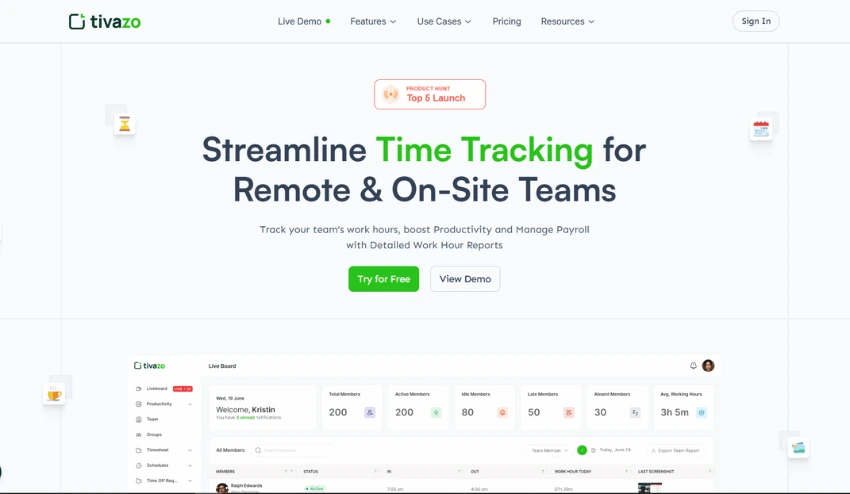
Conclusion
Building group synergy is essential for achieving high performance and innovation within teams. By fostering open communication, defining clear roles, and promoting trust, teams can unlock their collective potential. Are you ready to implement these strategies and enhance your team’s synergy?
